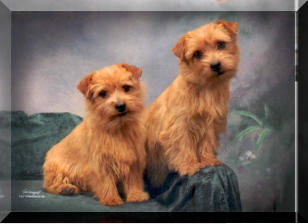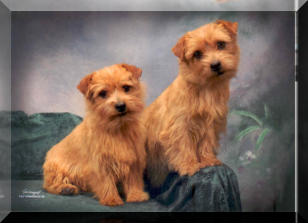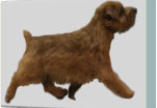


About


AKC Terrier Group
Height: Approximately 9 to 10 inches.
Weight: Approximately 11 to 12 pounds.
Availability: Will take some effort to find. We strongly advise that you research a potential
breeder to ensure you are not purchasing from a Commercial breeder. One good rule of
thumb is to ask the breeder for Norfolk Terrier club affiliations and verify those
affiliations. Also verify that the puppy is AKC registered.
History:
The Norwich and Norfolk Terriers started out as one breed, but were officially separated
in England in 1964. The AKC followed suit in 1979. The Norwich has prick ears and the
Norfolk, dropped ears. The breeds were originally developed in England as small ratting
dogs. Later they were also used to bolt foxes that had gone to ground during a fox hunt
so the horses and hounds could resume the chase. This small terrier could get in and out
of narrow burrows quite easily. As they were bred to hunt in packs, the Norfolk Terriers
tend to be more sociable than many other terriers. Today the Norfolk Terrier serves
primarily as a companion dog, but they can still take care of vermin.
Description:
A short-legged terrier with a harsh, wiry, straight coat and rounded drop ears. The tail is
docked, but should be left long enough to make a balanced outline. It is set high and
carried straight. The feet are rounded, with thick pads. The weather-resistant double coat
comes in many shades of wheaten, red, black-and-tan and grizzle. Dark points are
permitted, but white markings are not desirable.
Notes:
Generally a very healthy breed, but the Parent Club recommends several health
certifications, including CERF, Patella Luxation, Color Doppler (for MVD diagnosis). If your
potential breeder will not guaranty your puppy against these inheritable diseases, you
should reconsider your purchase.
Will dig and/or bark if left outside for long periods of time with nothing to occupy his
quick mind.
Loves toys and balls.
Can be difficult to housebreak.
Don't let off lead except in a secure area. His curiosity and intense focus will cause him to
bolt heedlessly across a busy street.
Can jog for short to moderate distances.
Personality:
Alert and devoted.
Feisty.
Charming and loving.
Outgoing and brave, assertive but not aggressive.
Some are one-person dogs; all want to be included in family life and activities.
Training for the Norfolk calls for consistent rules and basic obedience training.
Socialize well with other breeds as a puppy to avoid tendency toward timidity or
dominance.
Behavior:
Children: Good with children the age of reason.
Friendliness: Loves everyone.
Trainability: Moderately easy to train.
Independence: Very independent.
Dominance: Moderate
Other Pets: Generally good with other pets.
Combativeness: Not generally dog-aggressive.
Noise: Will bark when excited.
Grooming and Physical Needs:
Grooming: Regular grooming needed.
Trimming & Stripping: Skilled trimming or stripping needed.
Coat: Medium coat.
Shedding: Very light.
Docking: The tail is customarily docked.
Exercise: Moderate exercise needed.
Jogging: Small, but a pretty good jogging companion.
Indoors: Fairly active indoors.
Apartments: Will be OK in an apartment if sufficiently exercised.
Outdoor Space: Does all right without a yard if given adequate walks.
Climate: Does well in most climates.
Owner: Good for novice owners.
Longevity: Moderately long lived (12 to 15 years).
Talents: hunting, tracking, watchdog, therapy and agility.

Norfolk Terriers remain few in numbers across the country in
comparison to the more popular breeds. Although they are
limited in availability, there are occasional opportunities to
acquire a Norfolk from reputable sources. The benefits of
acquiring a dog from a responsible, reputable breeder
dedicated to producing quality dogs and available for advice
throughout the dog’s life should be obvious to anyone
endeavoring to purchase a puppy.
A reputable breeder will ascertain information about your
lifestyle, your family, your home and your schedule. Every
adult member of your family may be questioned regarding
their expectations of a dog. A responsible breeder will help
you understand the Norfolk personality and,if necessary guide
you to another breed more appropriate to meet your needs.





AKC Terrier Group
Height: Approximately 9 to 10 inches.
Weight: Approximately 11 to 12 pounds.
Availability: Will take some effort to find. We strongly advise that you research a potential
breeder to ensure you are not purchasing from a Commercial breeder. One good rule of
thumb is to ask the breeder for Norfolk Terrier club affiliations and verify those
affiliations. Also verify that the puppy is AKC registered.
History:
The Norwich and Norfolk Terriers started out as one breed, but were officially separated
in England in 1964. The AKC followed suit in 1979. The Norwich has prick ears and the
Norfolk, dropped ears. The breeds were originally developed in England as small ratting
dogs. Later they were also used to bolt foxes that had gone to ground during a fox hunt
so the horses and hounds could resume the chase. This small terrier could get in and out
of narrow burrows quite easily. As they were bred to hunt in packs, the Norfolk Terriers
tend to be more sociable than many other terriers. Today the Norfolk Terrier serves
primarily as a companion dog, but they can still take care of vermin.
Description:
A short-legged terrier with a harsh, wiry, straight coat and rounded drop ears. The tail is
docked, but should be left long enough to make a balanced outline. It is set high and
carried straight. The feet are rounded, with thick pads. The weather-resistant double coat
comes in many shades of wheaten, red, black-and-tan and grizzle. Dark points are
permitted, but white markings are not desirable.
Notes:
Generally a very healthy breed, but the Parent Club recommends several health
certifications, including CERF, Patella Luxation, Color Doppler (for MVD diagnosis). If your
potential breeder will not guaranty your puppy against these inheritable diseases, you
should reconsider your purchase.
Will dig and/or bark if left outside for long periods of time with nothing to occupy his
quick mind.
Loves toys and balls.
Can be difficult to housebreak.
Don't let off lead except in a secure area. His curiosity and intense focus will cause him to
bolt heedlessly across a busy street.
Can jog for short to moderate distances.
Personality:
Alert and devoted.
Feisty.
Charming and loving.
Outgoing and brave, assertive but not aggressive.
Some are one-person dogs; all want to be included in family life and activities.
Training for the Norfolk calls for consistent rules and basic obedience training.
Socialize well with other breeds as a puppy to avoid tendency toward timidity or
dominance.
Behavior:
Children: Good with children the age of reason.
Friendliness: Loves everyone.
Trainability: Moderately easy to train.
Independence: Very independent.
Dominance: Moderate
Other Pets: Generally good with other pets.
Combativeness: Not generally dog-aggressive.
Noise: Will bark when excited.
Grooming and Physical Needs:
Grooming: Regular grooming needed.
Trimming & Stripping: Skilled trimming or stripping needed.
Coat: Medium coat.
Shedding: Very light.
Docking: The tail is customarily docked.
Exercise: Moderate exercise needed.
Jogging: Small, but a pretty good jogging companion.
Indoors: Fairly active indoors.
Apartments: Will be OK in an apartment if sufficiently exercised.
Outdoor Space: Does all right without a yard if given adequate walks.
Climate: Does well in most climates.
Owner: Good for novice owners.
Longevity: Moderately long lived (12 to 15 years).
Talents: hunting, tracking, watchdog, therapy and agility.


Norfolk Terriers remain few in numbers across the country in
comparison to the more popular breeds. Although they are
limited in availability, there are occasional opportunities to
acquire a Norfolk from reputable sources. The benefits of
acquiring a dog from a responsible, reputable breeder
dedicated to producing quality dogs and available for advice
throughout the dog’s life should be obvious to anyone
endeavoring to purchase a puppy.
A reputable breeder will ascertain information about your
lifestyle, your family, your home and your schedule. Every
adult member of your family may be questioned regarding
their expectations of a dog. A responsible breeder will help
you understand the Norfolk personality and,if necessary guide
you to another breed more appropriate to meet your needs.















